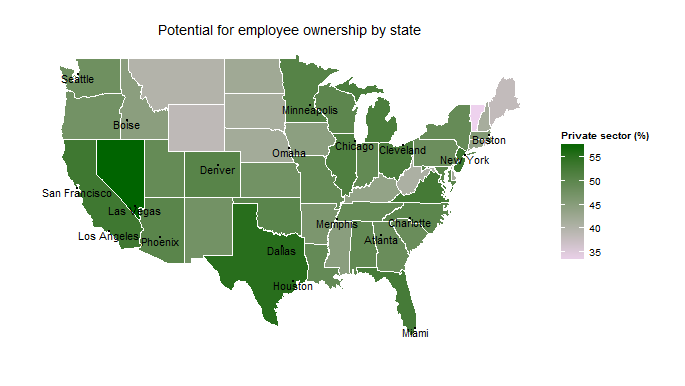by Thomas Dudley
For those interested in employee ownership, it is critical to understand if employee ownership can achieve the scale required to truly reduce wealth inequality and create strong local economies. In a previous post, we saw that today there are thousands of employee-owned business operating in every industry and employing up to 2 million Americans. But while there are numerous examples of large EO companies, as a whole, these firms account for about 1% of the civilian labor force.
The obvious question for those interested in advancing employee ownership is — how big can employee ownership become? Can it get to such a scale that it impacts a larger portion of that economy?
To answer this question, let’s think of existing employee-owned companies as proof-points that EO is a viable model in a particular industry for companies of a particular size. For example, let’s assume that WinCo Foods — a large grocery retailer with 100+ locations in 9 states that is 100% employee-owned — provides evidence that employee ownership is a viable model for other large grocery retailers such as Safeway and Kroger. With this assumption, we can estimate the potential size of employee ownership by looking at existing employee-owned companies and adding up the size of all companies similar to them.
Under this model, the key inputs to calculate the theoretical potential of employee ownership are a complete list of employee-owned companies and an industry/size breakdown of the entire private sector. Fortunately for us the latter is provided annual by the Census Bureau’s Statistics of U.S. Businesses(also known as the SUSB, we use the 2013 information). Unfortunately, we are missing a complete database of all employee-owned companies. But we do have an incomplete version of this list from my work on Certified Employee-Owned that contains 3,139 firms thought to be at least 30% EO (for more information, see the method used here).
This analysis yields the surprising result that over half of private sector employees could potentially be employee-owners. Specifically we find that potential size of employee ownership is roughly 60 million Americans working at 2.5 million business establishments. This is compared to a total private sector workforce of 116 million in our data. Therefore, employee-owned companies could be 52% of the private sector.
Breaking these numbers down by state yields some interesting patterns. First, all states have considerable EO potential, with low states clocking in at least 35% of their private sector (weighted by employee) having the potential to be employee-owned. Second, some surprising states present major opportunities for the expansion of employee ownership. The 5 States with the largest EO potential are: Nevada, Texas, New Jersey, California, and Virginia. In total, 15 states have an EO potential above 50%.

Looking forward, we can make additional assumptions to understand how the potential size of employee ownership will change in the future. In the year of our analysis (2013) the size of the civilian labor force — think of this as all people who are eligible to work regardless of current employment status — was roughly 155 million Americans. Looking forward, by 2050 the civilian labor force is expected to be roughly 200 million. Assuming the proportion of the civilian labor force that could be employee-owners is constant, then our analysis indicates that the potential size of employee ownership in 2050 is 77 million.
As with any sort of estimate, it’s important to understand how much the answer can change with changing assumptions. For example, in an early version of this analysis, using the same assumptions but a much less complete list of EO companies (only ~1,000 companies vs the ~3,100 used here), I found a potential size of 46 million employee-owners. Swings of 10 million or more were common when changing other assumptions, for example what constitutes an industry (defined by different levels of the North American Industry Classification System (NAICS) and what constitutes a “small”, “medium”, or “large” company.
In the final analysis we used the 4 digit NAICS code and defined size as follows: small (5–99 employees); medium (100–499 employees) and large (500+ employees). I would have liked to add more granularity for large firms, but was limited by the SUSB data. Most employees in the private sector work at large firms, so the analysis will be particularly sensitive to this assumption.
Despite the sensitivity to assumptions, overall the analysis presented here is conservative. I estimate there are between 6,000 and 8,000 companies in America that are at least 30% employee-owned, but here we are using a list of only ~3,100 companies. Most of the omitted companies are going to be small, but adding more companies can only increase the number of potential employee owners.
Regardless of the particular assumptions, one clear result of this analysis is that employee ownership could be much larger than it is today. This comes directly from seeing EO companies of all sizes operating in nearly every industry in the economy. Even conservative estimates make clear that there is enormous potential to bring employee-ownership to a much larger scale, affecting the larger economy, and changing the way we do business for the better.
